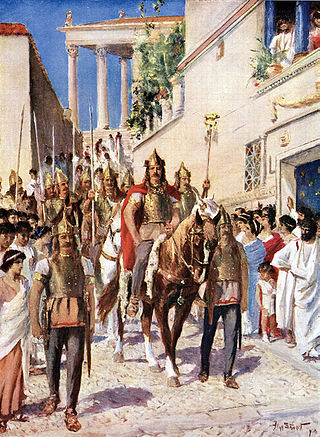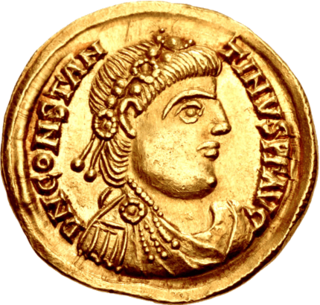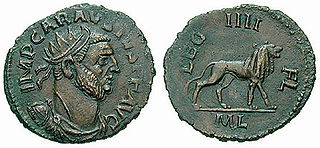Related Research Articles

Alaric I was the first king of the Visigoths, from 395 to 410. He rose to leadership of the Goths who came to occupy Moesia—territory acquired a couple of decades earlier by a combined force of Goths and Alans after the Battle of Adrianople.

Honorius was Roman emperor from 393 to 423. He was the younger son of emperor Theodosius I and his first wife Aelia Flaccilla. After the death of Theodosius in 395, Honorius, under the regency of Stilicho, ruled the western half of the empire while his brother Arcadius ruled the eastern half. His reign over the Western Roman Empire was notably precarious and chaotic. In 410, Rome was sacked for the first time in almost 800 years.
Fritigern was a Thervingian Gothic chieftain whose decisive victory at Adrianople during the Gothic War (376–382) led to favourable terms for the Goths when peace was made with Gratian and Theodosius I in 382.

Magnus Maximus was Roman emperor of the Western Roman Empire from 383 to 388. He usurped the throne from emperor Gratian.

Flavius Valerius Constantius "Chlorus", also called Constantius I, was Roman emperor from 305 to 306. He was one of the four original members of the Tetrarchy established by Diocletian, first serving as caesar from 293 to 305 and then ruling as augustus until his death. Constantius was also father of Constantine the Great, the first Christian emperor of Rome. The nickname Chlorus was first popularized by Byzantine-era historians and not used during the emperor's lifetime.

Valentinian I, sometimes called Valentinian the Great, was Roman emperor from 364 to 375. He ruled the Western half of the empire, while his brother Valens ruled the East. During his reign, he fought successfully against the Alamanni, Quadi, and Sarmatians, strengthening the border fortifications and conducting campaigns across the Rhine and Danube. His general Theodosius defeated a revolt in Africa and the Great Conspiracy, a coordinated assault on Roman Britain by Picts, Scoti, and Saxons. Valentinian founded the Valentinianic dynasty, with his sons Gratian and Valentinian II succeeding him in the western half of the empire.

Constantine III was a common Roman soldier who was declared emperor in Roman Britain in 407 and established himself in Gaul. He was recognised as co-emperor of the Roman Empire from 409 until 411.

Historia regum Britanniae, originally called De gestis Britonum, is a pseudohistorical account of British history, written around 1136 by Geoffrey of Monmouth. It chronicles the lives of the kings of the Britons over the course of two thousand years, beginning with the Trojans founding the British nation and continuing until the Anglo-Saxons assumed control of much of Britain around the 7th century. It is one of the central pieces of the Matter of Britain.

Dionotus was a legendary king of Cornwall in Geoffrey of Monmouth's Historia regum Britanniae, an account of the rulers of Britain based on ancient Welsh sources and disputed by many historians. Dionotus succeeding his brother Caradocus, and was regent of Britain during the campaigns in Gaul of Emperor Magnus Maximus. The curious thing about this king is that the Welsh chronicles, which parallel most of Geoffrey of Monmouth's book, do not mention this king by name. However, Geoffrey uses Latin versions of Welsh names so he could be referring to Dynod, duke of Cornwall, or Anwn Dynod, Maximus's own son.
Gracianus Municeps was a legendary King of the Britons, according to Geoffrey of Monmouth's Historia regum Britanniae, a largely fictional account of British history. "Municeps" translates to "freedman", meaning this individual was Gracianus the freedman. After the death of Roman Emperor Magnus Maximus, Gracianus seized the throne of Britain upon receiving word of Maximus's demise, by whose orders he had been sent to defend the attacked island while Maximus was campaigning on the continent.

The end of Roman rule in Britain was the transition from Roman Britain to post-Roman Britain. Roman rule ended in different parts of Britain at different times, and under different circumstances. In 383, the usurper Magnus Maximus withdrew troops from northern and western Britain, probably leaving local warlords in charge. In 407, usurper Constantine III took the remaining mobile Roman soldiers to Gaul in response to the Crossing of the Rhine in late 406, leaving the island a victim to barbarian attacks. Around 410, the Romano-British expelled the Roman magistrates from Britain. Roman Emperor Honorius replied to a request for assistance with the Rescript of Honorius, telling the Roman cities to see to their own defence, a tacit acceptance of temporary British self-government. Honorius was fighting a large-scale war in Italy against the Visigoths under their leader Alaric, with Rome itself under siege. No forces could be spared to protect distant Britain. Though it is likely that Honorius expected to regain control over the provinces soon, by the mid-6th century Procopius recognised that Roman control of Britannia was entirely lost.

Constans II was the son of Western Roman emperor Constantine III, and served as his co-emperor from 409 to 411. Constans was a monk prior to his father being acclaimed emperor by the army in Britain in early 407, an act of rebellion against the ruling emperor Honorius. He was summoned to Gaul, appointed to the position of caesar (heir) and swiftly married so that a dynasty could be founded. In Hispania, Honorius's relatives rose in 408 and expelled Constantine's administration. An army under the generals Constans and Gerontius was sent to deal with this and Constantine's authority was re-established. Honorius acknowledged Constantine as co-emperor in early 409 and Constantine immediately raised Constans to the position of augustus (emperor), theoretically equal in rank to Honorius as well as to Constantine. Later in 409 Gerontius rebelled, proclaimed his client Maximus emperor and incited barbarian groups in Gaul to rise up. Constans was sent to quash the revolt, but was defeated and withdrew to Arles. In 410, Constans was sent to Hispania again. Gerontius had strengthened his army with barbarians and defeated Constans; the latter withdrew north and was defeated again and killed at Vienne early in 411. Gerontius then besieged Constantine in Arles and killed him.
Venissa, according to Geoffrey of Monmouth's 12th century Historia Regum Britanniae, was a daughter of the Roman Emperor Claudius, whom he gave in marriage to the British king Arvirargus once he had submitted to Rome.

This is a chronology of warfare between the Romans and various Germanic peoples between 113 BC and 476. The nature of these wars varied through time between Roman conquest, Germanic uprisings and later Germanic invasions of the Western Roman Empire that started in the late second century BC. The series of conflicts was one factor which led to the ultimate downfall of the Western Roman Empire in particular and ancient Rome in general in 476.
Gratian or Gratianus was a Roman usurper in Roman Britain from 406-407.
Lucius Tiberius is a Western Roman procurator or emperor from Arthurian legend, who is killed in a war against King Arthur. First appearing in Geoffrey of Monmouth's Historia Regum Britanniae, Lucius also appears in later, particularly English literature such as the Alliterative Morte Arthure and Thomas Malory's Le Morte d'Arthur. The motif of a Roman Emperor defeated by Arthur appears in the Old French literature as well, notably in the Vulgate Cycle.

Between 376 and 382 the Gothic War against the Eastern Roman Empire, and in particular the Battle of Adrianople, is commonly seen as a major turning point in the history of the Roman Empire, the first of a series of events over the next century that would see the collapse of the Western Roman Empire, although its ultimate importance to the Empire's eventual fall is still debated. It was one of the many Gothic Wars with the Roman Empire.

The Carausian revolt (AD 286–296) was an episode in Roman history during which a Roman naval commander, Carausius, declared himself emperor over Britain and northern Gaul. His Gallic territories were retaken by the western Caesar Constantius Chlorus in 293, after which Carausius was assassinated by his subordinate Allectus. Britain was regained by Constantius and his subordinate Asclepiodotus in 296.
The crossing of the Rhine River by a mixed group of barbarians which included Vandals, Alans and Suebi is traditionally considered to have occurred on the last day of the year 406. The crossing transgressed one of the Late Roman Empire's most secure limites or boundaries and so it was a climactic moment in the decline of the Empire. It initiated a wave of destruction of Roman cities and the collapse of Roman civic order in northern Gaul. That, in turn, occasioned the rise of three usurpers in succession in the province of Britannia. Therefore, the crossing of the Rhine is a marker date in the Migration Period during which various Germanic tribes moved westward and southward from southern Scandinavia and northern Germania.
Sarus or Saurus was a Gothic chieftain, known as a particularly brave and skillful warrior. He became a commander for the emperor Honorius. He was known for his hostility to the prominent Gothic brothers-in-law Alaric I and Athaulf, and was the brother of Sigeric, who ruled the Goths briefly in 415.
References
- ↑ Jones, pg. 719
- ↑ Zosimus, 6:2:1; Birley, pg. 458
- ↑ Birley, pg. 457
- ↑ Bury, pg. 138
- ↑ Birley, pp. 456-459
- ↑ Baynes, N. H., Journal of Roman Studies, 12 (1922), pp. 417ff
- ↑ Kulikowski, M, Brittania, 31 (2000), pp. 326ff
- ↑ Paschoud, F., Zosime, Histoire Nouvelle, i2. Livres I et II (2nd edn., 2000), iii. 2 n. 115, 20ff. n. 119, 28ff
- ↑ Birley, pp. 457-459
- ↑ Birley, pp. 458-459
- ↑ Zosimus, 6:2:1
- ↑ Birley, pg. 458
- ↑ Monmouth, Historia Regum Britanniae, 6:1